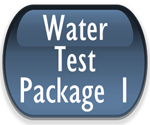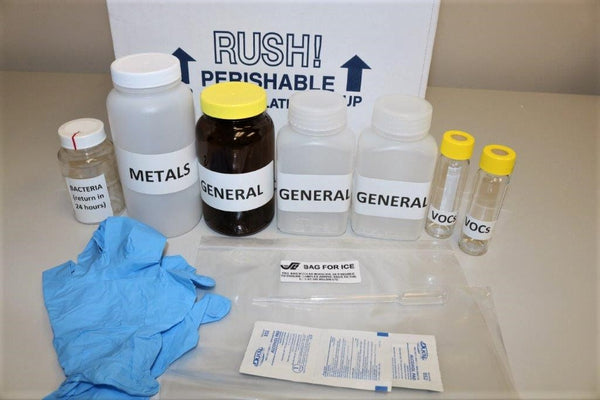Safe Water Package #1
Test for Most Common Contaminants in Drinking Water
The Safe Water Test Package 1 is a comprehensive package of tests for all water types and includes the most common drinking water contaminants. The package includes all the tests from Safe Water Test Package 2, Metals Package 1, Hard Water Check, Pesticides/Herbicides Screen and VOCs. This is an excellent package for homeowners or businesses who want a thorough analysis of their water.
This Package Includes 46 Individual Contaminants:
|
Contaminant |
EPA MCL |
Potential Health effects from |
Common sources of |
|
Total Coliform |
zero presence |
Indicate whether potentially harmful bacteria may be present |
Coliforms are naturally present in the |
|
Nitrates, Total |
10 |
Infants below the age of six months who drink water containing nitrate in excess of the MCL could become seriously ill and, if untreated, may die. Symptoms include shortness of breath and blue-baby syndrome. |
Runoff from fertilizer use; leaching from septic tanks, sewage; erosion of natural deposits |
| Iron | 0.3 | Possible liver problems; unpleasant metallic taste | Erosion of natural deposits; corrosion from cast iron pipes or steel |
|
Antimony |
0.006 |
Increase in blood cholesterol; decrease in blood sugar. |
Discharge from petroleum refineries; fire retardants; ceramics; electronics; solder. |
|
Arsenic |
0.010 |
Skin damage or problems with circulatory systems, and may have increased risk of getting cancer |
Erosion of natural deposits; runoff from orchards, runoff from glass and electronics production waste. |
|
Barium |
2 |
Increase in blood pressure |
Discharge of drilling wastes; discharge from metal refineries; erosion of natural deposits |
|
Beryllium |
0.004 |
Intestinal lesions |
Discharge from metal refineries and |
|
Cadmium |
0.005 |
Kidney damage |
Corrosion of galvanized pipes; erosion of natural deposits; discharge from metal refineries; runoff from waste batteries and paints |
|
Chromium (total) |
0.1 |
Allergic dermatitis |
Discharge from steel and pulp mills; erosion of natural deposits |
|
Copper |
Action |
Short term exposure: Gastrointestinal distress. Long term exposure: Liver or kidney damage. People with Wilson’s Disease should consult their personal doctor if the amount of copper in their water exceeds the action level |
Corrosion of household plumbing systems; erosion of natural deposits |
|
Lead |
Action |
Infants and children: Delays in physical or mental development; children could show slight deficits in attention span and learning abilities; Adults: Kidney problems; |
Corrosion of household plumbing |
|
Mercury (inorganic) |
0.002 |
Kidney damage |
Erosion of natural deposits; discharge |
|
Selenium |
0.05 |
Hair or fingernail loss; numbness in fingers or toes; circulatory problems |
Discharge from petroleum refineries; |
|
Thallium |
0.002 |
Hair loss; changes in blood; kidney, intestine, or liver problems |
Leaching from ore-processing sites; discharge from electronics, glass, and drug factories |
|
Alkalinity |
n/a |
High alkalinity water has an objectionable taste |
Alkalinity of water is a measure of how much acid it can neutralize. |
|
Calcium |
n/a |
Calcium is a dietary mineral |
Erosion of natural deposits |
|
Hardness, Total |
n/a |
n/a |
Erosion of natural deposits |
|
Magnesium |
n/a |
Magnesium is a dietary mineral |
Erosion of natural deposits |
|
pH |
n/a |
High or low pH can cause the water to taste or smell bad. |
pH is a figure expressing the acidity or alkalinity of water with a scale of 1 to 14 on which 7 is neutral, lower values are more acidic and higher numbers are more alkaline or basic. |
|
Sodium |
n/a |
Increase risk of high blood pressure; Unpleasant taste |
Erosion of natural deposits |
|
Turbidity |
n/a |
Turbidity is a measure of the cloudiness of water. It is used to indicate water quality and filtration effectiveness. Turbid water can cause short term symptoms such as nausea, cramps, diarrhea, and associated headaches. |
Soil erosion and runoff and discharges |
|
Benzene |
0.005 |
Anemia; decrease in blood platelets; Increased risk of cancer |
Discharge from factories; leaching from gas storage tanks and landfills |
|
Carbon Tetrachloride |
0.005 |
Liver problems; increased risk of cancer |
Discharge from chemical plants and other industrial activities |
|
Chlorobenzene |
0.1 |
Liver or kidney problems |
Discharge from chemical and Agricultural chemical factories. |
|
1,2-Dichlorobenzene |
0.6 |
Liver, kidney, circulatory system problems |
Discharge from industrial chemical factories |
|
1-4-Dichlorobenzene |
0.075 |
Anemia; liver, kidney or spleen damage; changes in blood |
Discharge from industrial chemical factories |
|
1,2-Dichloroethane |
0.005 |
Increased risk of cancer |
Discharge from industrial chemical factories |
|
1,1-Dichloroethene |
0.007 |
Liver problems |
Discharge from industrial chemical factories |
|
cis-1,2-Dichloroethene |
0.07 |
Liver problems |
Discharge from industrial chemical factories |
|
trans-1,2-Dichloroethene |
0.1 |
Liver problems |
Discharge from industrial chemical factories |
|
Methylene Chloride |
0.005 |
Liver problems; increased risk of cancer |
Discharge from drug and chemical factories |
|
1,2-Dichloropropane |
0.005 |
Increased risk of cancer |
Discharge from industrial chemical factories |
|
Ethylbenzene |
0.7 |
Liver and kidney problems |
Discharge from petroleum refineries |
|
Methyl tertiary butyl ether (MTBE) |
n/a |
Possible cancer risk |
leaking gasoline storage tanks, pipelines and emissions |
|
Styrene |
0.1 |
Liver, kidney & circulatory system problems |
Discharge from rubber and plastic factories; leaching from landfills |
|
Tetrachloroethene |
0.005 |
Liver problems; increased risk of cancer |
Discharge from factories and dry cleaners |
|
Toluene |
1 |
Nervous system, kidney, or liver problems |
Discharge from petroleum factories; or underground gasoline tanks |
|
1,2,4-Trichlorobenzene |
0.07 |
Changes in adrenal glands |
Discharge from textile finishing factories |
|
1,1,1-Trichloroethane |
0.2 |
Liver, nervous system, or circulatory problems |
Discharge from metal degreasing sites |
|
1,1,2-Trichloroethane |
0.005 |
Liver, kidney, or immune system problems |
Discharge from industrial chemical |
|
Trichloroethene |
0.005 |
Liver problems; increased risk of cancer |
Discharge from metal degreasing sites |
|
Vinyl chloride |
0.002 |
Increased risk of cancer |
Leaching from PVC pipes; discharge from plastic factories |
|
Xylenes (total) |
10 |
Nervous system damage |
Discharge from petroleum factories and chemical factories |
Your test kit will include sample bottles and easy to follow sample collection instructions. When testing is complete, a report will be issued identifying any problems detected with your sample. Please note: this test package must be returned to the lab within 24 hours of collection.







